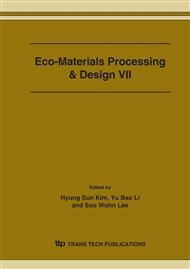p.634
p.638
p.642
p.646
p.650
p.654
p.658
p.662
p.666
Characterization of Friction Materials Reinforced by Porous Mullite
Abstract:
Mullite reinforced composites were produced by the injection molding technique to develop environmentally friendly friction materials for automotive applications. In order to examine the effect of mullite content on the friction and wear properties, two different specimens containing 10wt% and 30wt% of mullite were respectively fabricated and wear-tested by using the plate-on-disc type sliding friction and wear test machine. The sliding friction and wear test demonstrated that both specimens show similar tendencies at different sliding speeds under a low load of 2.9N. In comparison with common glass fiber reinforced composites, both of the mullite reinforced composites exhibited a lower wear rate at room temperature.
Info:
Periodical:
Pages:
650-653
Citation:
Online since:
March 2006
Authors:
Price:
Сopyright:
© 2006 Trans Tech Publications Ltd. All Rights Reserved
Share:
Citation:


